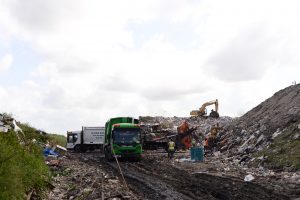PREPARATORY work on cell two of the Haags Bosch Landfill is expected to begin this week, with hopes that the cell could begin accepting waste at least by January 2020, since cell one has almost reached its full capacity.
In an interview with the Guyana Chronicle, Ministry of Communities (MoC) Head of Sanitation, Gordon Gilkes, explained that the $290 million contract for work on cell two was awarded to S. Jagmohan Hardware Supplies and Construction Services, the same contractor that eventually completed works on cell one.
“Cell one has met its present capacity to the limit that it could take at this time, so we’re working towards completing the first phase of cell two by December 2019, so we can start accepting waste, even though the contract is due to be completed at the end of 2020,” Gilkes explained.

“Nothing was done on the ground as yet because of the inclement weather. However, now that we have [an] ease in the weather we have written the contractor to begin work on the ground. The contract requires use of a significant amount of overseas-based materials, which have been ordered and should start coming in the country from next week. By mid-September we should be able to get all the overseas-based materials which include geo fabric, HDPE pipes, which ought to be used at the base of the land fill for drainage. In the meantime, we ae going to start preparing the ground to put these pipes and synthetic materials.”
Cell one has been taking waste since 2011, and had an original estimated lifespan of approximately eight years. However, good management has seen the cell being extended.
According to Gilkes, the expected life span of cell two is estimated to be approximately 10 years. He however acknowledged the rate of waste that comes into the landfill continues to increase which puts some amount of uncertainty on the lifespan.
This is further compounded by the uncertainty that exists over the waste expectations from the oil and gas industry, which comes on stream next year. However, there are means by which the waste can be reduced.
“The landfill was designed probably in 2004, and expected about 250 tonnes a day. Five years ago it was at about 310 tonnes per day and since then it has increased over time. So right now we are accepting in excess of 400 tonnes per day,” Gilkes revealed.
“It will affect the time span, but if we do more waste diversion, if we divert the plastic, if we divert the cardboard, the landfill would not fill as fast, and we also have to compact it. That’s why we’re encouraging persons to reduce, reuse and recycle. Once we get persons to apply three R’s, I think 10 years is a good thing. With the Oil and Gas sector coming on stream we expect more waste. We have to review that ten years. Because presently we don’t know the amount of waste we will get from oil and gas.”
Other waste such as metals, builders waste, tires, are stockpiled and stored separately and do not go to the landfill cells.
A number of dumpsite “pickers”, persons who scavenge through the dump for valuables, also aid in removing certain types of waste from the landfill.

At its conception the landfill was estimated to have a life of some 25 – 28 years. The entire facility covers some 150 acres, of which 64 acres go towards the cells for the storage of the waste, the 64 acres is divided into four 16 acres plots each. The infrastructure also includes a number of facilities.
“We have the building scale, waste stabilization pond, areas for the storage of metals, storage builders waste, picker shed, [and] storage areas,” Gilkes explained.
Notwithstanding its long lifespan, space at the landfill will soon all be used up. Gilkes said the options of what would happen next is still one being explored and considered, even as works to have more landfills established, including regional landfills, continues.
“Getting land for landfill in Guyana is an uphill task. Maybe during this time, we initiate the feasibility and viability of a waste to energy plant, producing energy from waste. Because in developed countries waste goes to a waste energy plant to burn the waste and produce electricity,” Gilkes shared,
“We could also look at options of utilizing the organic waste to do anaerobic digestion. So we have to look at the feasibility of waste options because land for landfill [is]becoming more scarce and land is valuable.”
The landfill currently utilises a number of methods to improve the quality of the facility, including the covering of the waste in layers, which prevents fires and helps with odour. Gilkes said the landfill is not entirely where it needs to be just yet, but with steady progress it will get there.
“Covering the waste is very important. It reduces the incidents of fires, odour emanating from the waste, there are birds, and vectors, so it acts as a barrier to these things. So as to safeguard human health and environment.”
Gilkes further pointed out, “We are not quite there yet, but we’ve come a long way from when we would’ve started. There are still some areas for better management or operation. Once we improve, small incremental improvements over time, eventually we will get there. Because operation of the landfill is fairly new in Guyana,”




.png)









